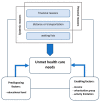Unmet Health Care Needs of the Older Population in European Countries Based on Indicators Available in the Eurostat Database
- PMID: 37830729
- PMCID: PMC10572618
- DOI: 10.3390/healthcare11192692
Unmet Health Care Needs of the Older Population in European Countries Based on Indicators Available in the Eurostat Database
Abstract
Access to healthcare may affect the health of the population, especially older people. The aim of this study is to analyze the reasons and factors influencing the unmet healthcare needs (UHCN) of the older population in the context of differences between age groups for 28 European countries. A self-reported UHCN indicator obtained from Eurostat database was used. The share of people with healthcare needs reporting distance/transportation issues was significantly different in the younger and older groups, as well as in age groups within the older population. The differences in other reasons were not so considerable. Problems with UHCN were observed more often in the older population with lower rather than with higher income and with more severe activity limitations rather than with none/moderate limitations (differences statistically significant, except for income for 75+). In most countries, the UHCN dependence on income/activity limitation is higher in the age group of 15-64 than for the older population. To plan/introduce/monitor appropriate, tailored actions for improving healthcare access for the older population, a detailed analysis of the UHCN prevalence, reasons, and determinants in this age group is needed; it is insufficient to analyze only the population as a whole. Additionally, the group of older people is not homogeneous in terms of UHCN.
Keywords: access to health care; age groups; older population; unmet health care needs; waiting lists.
Conflict of interest statement
The author declares no conflict of interest.
Figures






References
-
- World Health Organization Integrated Care for Older People. Realigning primary health care to respond to population ageing. Tech. Ser. Prim. Health Care. 2018;1:24.
-
- Lawrence R. Understanding Environmental Quality Through Quality of Life (QOL) Studies. Landsc. Urban Plan. 2003;65:73–83. doi: 10.1016/b978-0-12-409548-9.09139-9. - DOI
Grants and funding
LinkOut - more resources
Full Text Sources

